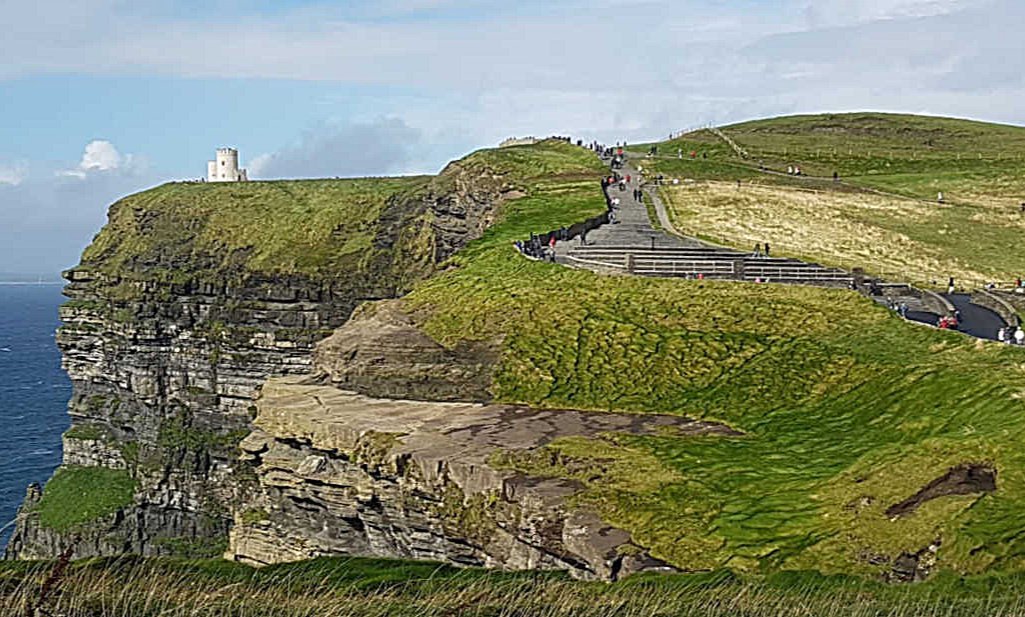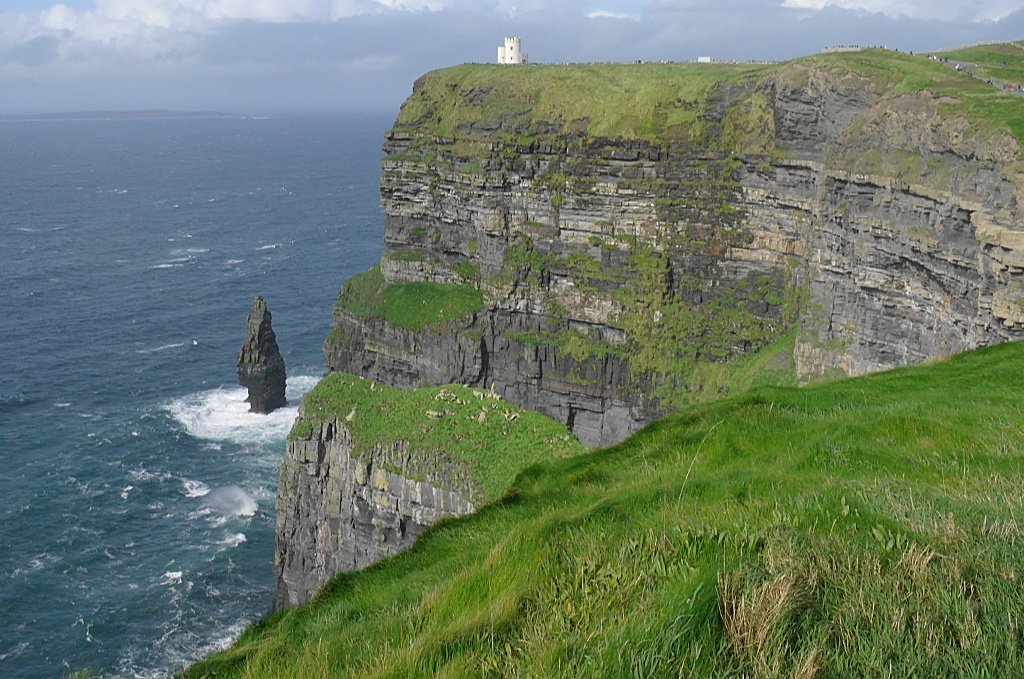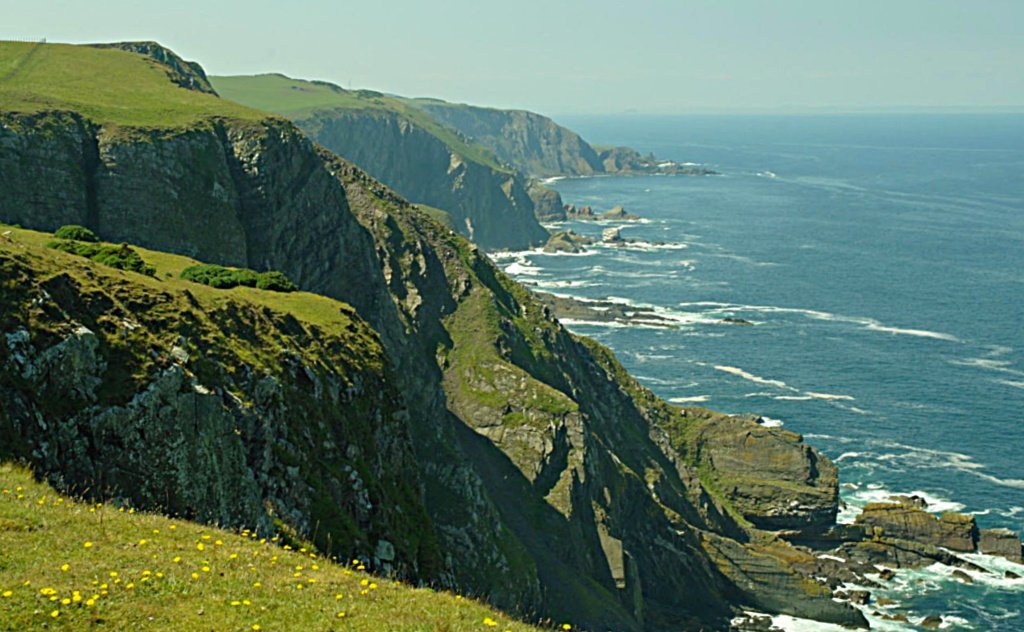Ireland’s Cliffs of Moher are an easy journey from Galway City. But how exactly do huge cliffs and a million and a half tourists annually actually work as a visitor experience?
In fact, what is this fascination about big cliffs, in both Ireland and Scotland? Both nations have some whoppers: scary, airy verticals to intimidate the vertigo-prone; rock faces and ledges that are, mostly, undisturbed so that the seabird tribe can get on with its domestic life.
Unlike many other scenic spots over-run by visitors, cliffs aren’t easy to ‘exploit’ or – a more kindly description – interpret, for the benefit of folk looking for a taste of wildness. There are few exceptions and the main one is the Cliffs of Moher in County Clare, Ireland.

These impressive seascapes are certainty not lonely spots where you will meet only a few walkers or birders. Far from it: they attract more than a million and a half visitors a year – a fact which does not trouble Mr and Mrs Kittiwake, down below, in the slightest.
No, the birds just caress and bicker on the tiny circle of dried seaweed they call home, along with countless others, all utterly oblivious to the tramp of feet on the cliff-edge paths above.
Not that the visitors to the Cliffs of Moher just stroll along the clifftop. There is a comprehensive visitor centre.
By the way, we went on a day trip from Galway…easy and not too long! Take a look below…
Cliffs of Moher Visitor Centre
The main centre is built right into the landward slope and, though it has the faint air of a Cold War Civil Defence bunker, it has everything that modern tourism expects – from leprechaun tea-towels to comprehensive display boards, fruit scones to a continuously running audio-visual.
With just the faintest air of sanctimony, the centre claims that it ‘nestles into the hillside minimising the visual impact on this fabulous scenic location’. No, you’d hardly know it was there. Oh, wait, apart from the humongous bus park and the adjacent car park.
There’s a quite reasonable entrance fee as well, payable between the carpark and the centre. Or you can book in advance and enjoy cheaper prices if you come off-peak.
The visitor centre itself is very informative – that’s all that needs to be said, really. The exhibition covers the nature and the geology – basically, the story of the area.

The main elements of the Cliffs of Moher visit comprise: admiring the cliffs themselves from a variety of viewpoints (obviously); walking along the tops; taking in the well-resourced visitor centre; browsing in the shop; refuelling at the cafe. There is also a row of souvenir-type shops lining the main visitor centre approach from the parking areas.

And that’s what more than 1.5 million visitors enjoy every year. The venue is sometimes described as Ireland’s most popular tourist attraction.
What to see here
Yes, they come from all over the world to see some quite large cliffs made of layers of sedimentary rock. These sandstones are crumbly and prone to erosion and even sudden rockfalls – a fact that many visitors, keen to demonstrate they are immune to vertigo, prefer to ignore.
At their highest point these sheer cliffs top 702ft (214m) and stretch for five miles (eight km) on the edge of the Atlantic. That makes them the third highest cliffs in Ireland.

Are the Cliffs of Moher the highest in Ireland?
I know what you’re thinking…Yes, I thought they would be the tallest too, but not so.
Sliab Liag in Donegal is higher and Croaghaun sea cliffs (2,257 ft / 688m) on the west side of Achill Island, County Mayo, higher still.
And 2019 saw the announcement of an investment in the ‘cliff peaks’ of Sliab Liag, which one Irish newspaper describes as the highest in Europe, though that actually isn’t true. (Journalists in a hurry, eh?) It looks like the tourism folk in Donegal are setting up in competition.
In any case, when does a steep slope become a cliff? Do cliffs by definition have to be vertical? Without becoming too pedantic, both of Moher’s ‘competing’ cliffs, Sliab Liag and Achil Island, don’t look sheer to me – at least not all the way down.
Hypothetically, hurling yourself from the summits would mean rolling a long way – plus a couple of bounces – rather than instantly experiencing the terminal joy of Newton’s Second Law of Gravity, as it would be in the case of the vertical faces of the Cliffs of Moher.
Oh, I don’t know, maybe I’m making too much of this.

Anyway, back at Moher, what we have here is a fine example of taking a chunk of spectacular terrain and turning it into a mega-attraction that can handle large numbers of visitors.
And it’s the combination of natural feature with well-developed visitor centre that is fairly unusual.
A natural feature with a lot of visitors
In contrast, Scotland’s own high figure visitor attractions are nearly all ‘man-made’, I mean ‘person-made’ – say, Edinburgh Castle or the National Museum of Scotland (c. 2 million visitors each)
Perhaps the nearest equivalent to the Cliffs in Scotland would be Loch Ness. Sure, it’s a natural feature, but this fairly attractive big loch still needed a monster bit of promotion to draw folk from across the world.
For sure, nearly half a million folk annually come to Urquhart Castle on the banks of the loch – but even then, Loch Ness is on the way to and from somewhere else, for example, Inverness. The Irish cliffs here seem more ‘out of the way’.
They certainly must feel that way if you are, for instance, basing yourself in Dublin and decide to visit the Cliffs of Moher. In this case you have approximately a 340 mile / 544km round trip. Several coach tour companies offer day trips from the Irish capital.
It makes our day out (by coach from Galway), at a mere 96 miles / 152 km there and back, a mere hop by comparison, even if it did include Corkscrew Hill in the Burren. Its name is self-explanatory, but our driver took it with finesse.

Walking on the Cliffs of Moher
The minimum distance between visitor centre and a cliff view is a short way along a smooth walkway and should be accessible for most.
Many visitors then go on to climb the wide steps (also a parallel pathway) up to O’Brien’s Tower, from where there is a grand panorama. The tower was built in 1835 by the then landowner and marks the highest point of the cliffs.
Basically then, the area above and below the visitor centre is well-marked and safe underfoot. Cleverly, the pathway in the vicinity of the centre – and thus with the heaviest ‘footfall’ – is edged by high slabs of local stone. These almost shoulder-high slab discourage most of the tourists from approaching too closely to the drop.
(Don’t know about you, but I find I’m simultaneously repelled by the height while being magnetically drawn to the edge!)
Could You fall off the Cliffs of Moher?

Quite easily is the short answer. Just how dangerous this area can be is confirmed by the range of dire warning notices.
These are obviously aimed at visitors with an under-developed sense of self-preservation. Or perhaps just morons on holiday.
Most of the these warning signs are where the well-maintained centre path stops and becomes a narrower, sometimes muddier, track both to the north and south. (It’s part of the Wild Atlantic Way.)
However, even alarming drops from eroding and crumbling edges don’t stop quite a few visitors from deciding that one more selfie is worth the risk of spoiling their party’s visit by ending their day out early.
How? Obviously by that same visitor, phone still in hand, arriving at the base of the cliff at approximately 150 miles per hour about six seconds after their departure from the edge. (That’s 240 km/hr if you are falling metrically, as well as vertically.) This assumes that Newton’s Second Law applies, though the figures are for a vacuum.
Spending a little time just people-watching here is a good way to remind yourself that much of the human race is prone to risk-taking, or maybe just selfie-taking, in potentially dangerous circumstances while on vacation.
Seriously, in 24 years, 66 people have died here, according to the Journal of Travel Medicine report called ‘An analysis of international traveller deaths at the Cliffs of Moher in Ireland, 1993-2017’. This is not cheerful bed-time reading.
Still, I wouldn’t worry. The wonder of it all is that the chances are very much in your favour that you will not only survive but really enjoy your visit here! (You have a one in 545,000 possibility – call it half a million or so – of becoming a statistic, roughly.)

Best time to visit Moher?
Again, it’s obvious that a visit on a sunny summer day will be the most rewarding and comfortable, as it is for most tourism destinations (except ski resorts maybe). Our visit was on a blustery, showery late September day, as it happened. Visibility was no more than OK.
The Aran Islands were just visible but we certainly couldn’t see America, though there was nothing in between.
Wearing our sensible footwear and windproof jackets, oh how smug we felt overtaking a Chinese tour group. The ladies of the group were prinked and coiffured, high fashion accessories were much in evidence, while their footwear mostly comprised delicate little pumps.
Aye, just the thing when it’s blowin’ a hoolie on the west coast of Ireland! Obviously, not just footwear but fitness and time available will dictate how many of the views you take in. For us Scots, it was a curious experience. Back home, cliffs – not always as high as Moher – usually mean places where often visitors are few and far between.

In contrast to the Scottish cliffs pictured above, on these huge Irish cliffs you share the wide Atlantic seascapes with streams of walkers going in both directions, some on the main path, a few so close to the edge that you mostly want to look away and keep hiking on.
It’s such a contrast to, say, St Abbs in the Scottish Borders (seabirds galore) or Troup Head on the Moray Firth (to see the gannet colony), or even Marwick Head on Orkney (like Troup Head another RSPB reserve).
These three Scottish examples are all visited quite frequently and certainly on many visitors’ itineraries – but in nothing like the sheer volume of the Cliffs of Moher.
Are the Cliffs of Moher worth the time?
A million and a half visitors can’t be wrong. As said above, if you like your cliffs wild and remote then this isn’t for you. But as can be seen by the state of the pathways further out from the main centre, this has been a popular excursion for generations.
If you are of a birdy inclination then you will see not just kittiwakes as alluded to earlier but also the ‘usual’ auks and, yes, those ever-so cutesy puffins. The seabird colonies of spring and summer will be the most obvious denizens of the rock-faces.
Visit in autumn and you’ll find the cliff faces are empty. You should also see choughs – a corvid rarity in Scotland, but certainly around in the west of Ireland. Look for a crow with red legs and beak.
There are other things as well. You might see a peregrine. But then, you might see a peregrine – almost by definition – just about anywhere.
The main website for the cliffs also lets you know (at time of writing) that the cliffs ‘are home to many rare flora (sic) including Cat’s Eat (sic) and Sea Pink’. This refers to the common dandelion-type flower usually called cat’s ear, and the even commoner and widespread thrift.
Reading between the lines, it suggests that there are many reasons for visiting the cliffs, but botany might not be one of them. Best go to the Burren instead.
More pages on Ireland
Yes, I know this is mostly a site about Scotland – it’s just that we love Ireland too. (In fact, we’re quite jealous of it, but in a good way.) So here are some more information-loaded pages to help you choose between the two…
First of all, Scotland or Ireland? Do these two Celtic nations on the edge of Europe offer the same kind of experience? Perhaps. We’ve known Scotland all our days, but – like we say – love Ireland.
One of the best ever days we had in Ireland was spend exploring the Burren. It has no exact equivalent in Scotland. A highly unusual limestone landscape with bare ‘pavement’, cliffs, hazel thickets and a treasury of wild flowers.
Like the Cliffs of Moher, we had a day at the Burren from our base in Galway. Join us for a stroll around Galway City. We love its relaxed ambience, we had a Guinness or two, and wished some of Scotland’s cities could be more like it.
So much to see and do in the west of Ireland. Connemara’s ruggedness may come as a surprise – it’s yet another impressive landscape showing the diversity of Ireland. Join us on a Connemara excursion.
Also fascinating was a visit to Cong – a little town completely immersed in its connections to that well known misogynistic, racist…oh, wait, I mean Hollywood star, John Wayne. Cong and the Quiet Man suggests you can live off the reputation of a successful movie for decades.
There is quite a big accommodation range in Galway.
We also recommend Rabbie’s Tours to take you to the best bits of Ireland. Explore small group tours of Ireland with Rabbie’s.